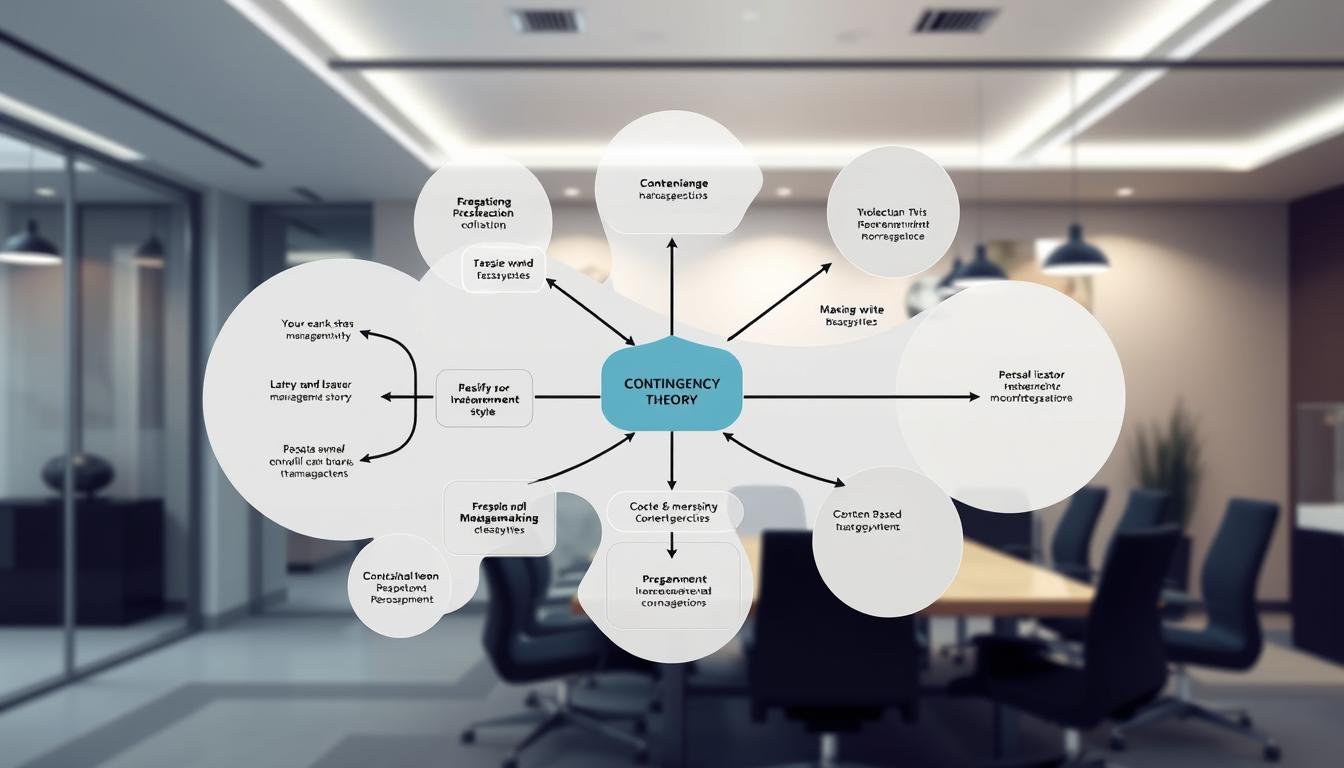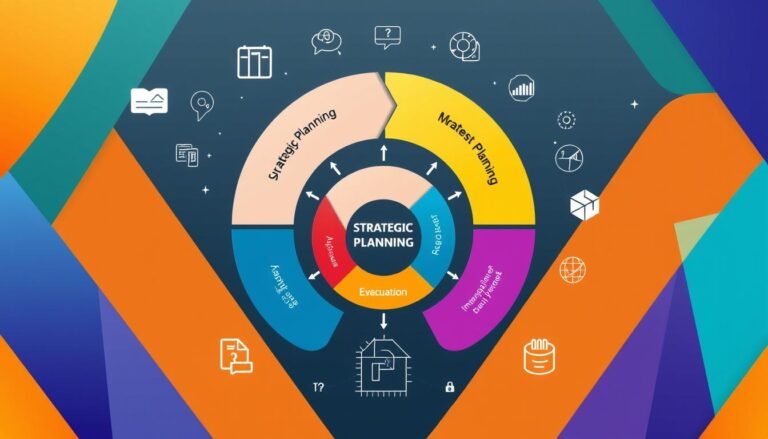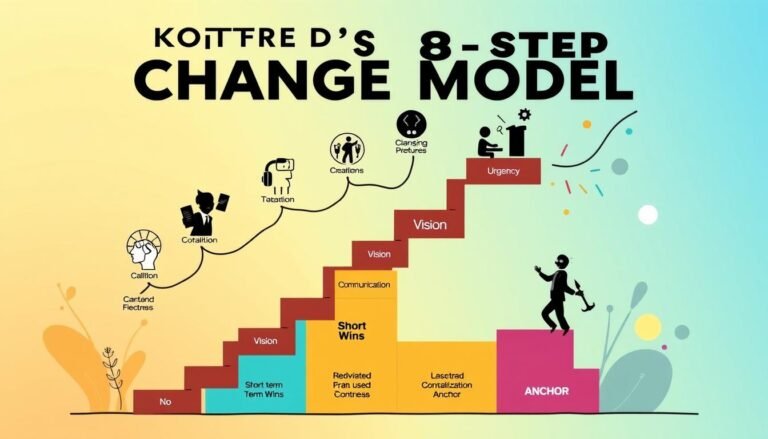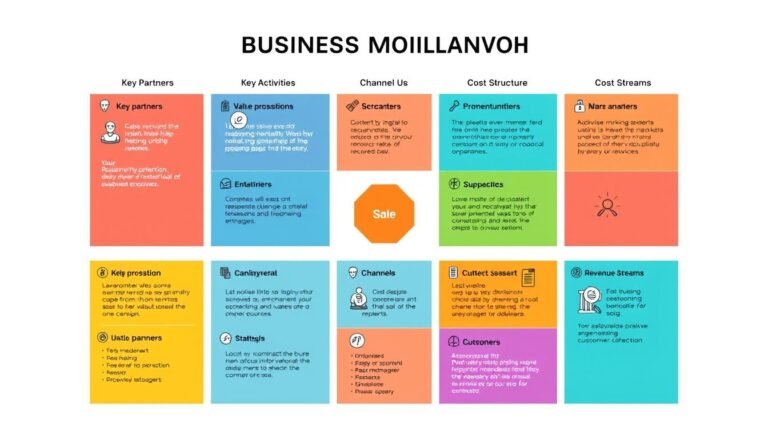Understanding Contingency Theory in Management
Have you ever thought about why some leaders do well in certain situations but not others? They might have the same skills and knowledge. This brings us to Contingency Theory. It says there’s no one best way to lead a team. Instead, it’s all about how well leaders can adapt to different situations.
This theory is all about being flexible. Leaders need to change how they lead based on the situation. It’s about knowing what’s best for the team and the task at hand.
Contingent Leadership is simple: managers must look at the team, the task, and the people to find the best way to reach goals. This way, teams can work better together and achieve more.
By using this approach, companies can create a more flexible management structure. This helps everyone work better together and makes the organization more effective.
Key Takeaways
- Contingency Theory highlights the necessity for adaptable leadership.
- Leadership effectiveness varies significantly based on situational contexts.
- Real-world applications of the theory can enhance decision-making processes.
- Understanding team dynamics is crucial for effective management.
- Various models, like Fiedler’s, guide the application of Contingency Theory.
What is Contingency Theory?
Contingency Theory is a key part of Leadership Theory. It shows how the situation affects a leader’s success. This theory started in the 1960s as a way to improve old management ideas. It says a leader’s success depends on their traits and the situation they’re in. This makes leadership more complex and interesting.
Definition and Historical Context
Contingency Theory changed Leadership Theory by showing the need for flexible leadership. Early thinkers like Fred Fiedler linked a leader’s actions to the situation they’re in. They found important factors like how well the leader knows their team, the task at hand, and their power level. These factors greatly affect leadership success.
Studies supported this theory, showing how leadership and the environment work together. They proved that different situations need different leadership styles.
Key Proponents and Their Contributions
Many experts have helped grow Contingency Theory. Fred Fiedler is a big name who laid the groundwork for understanding leadership. Roya Ayman and Martin Chemers showed how leaders and their teams connect and the leader’s control over the situation matter a lot. The Ohio State and University of Michigan studies found important leadership styles, like focusing on tasks or people.
These studies have given us a strong way to see how leadership works in different places.
| Key Component | Description |
|---|---|
| Leader-Member Relations | The quality of interpersonal relationships between leaders and their team members, affecting trust and communication. |
| Task Structure | The extent to which tasks are clearly defined and structured, influencing the leader’s ability to guide their team effectively. |
| Position Power | The degree of power a leader holds to influence subordinates, arising from their role and authority in the organization. |
Core Concepts of Contingency Theory
Contingency theory is all about key ideas that help leaders deal with different work settings. It’s important for leaders to grasp these ideas to handle the challenges of their job. The way leaders connect with their team, the tasks they give out, and their power in the organization affects how well they can adjust to new situations.
Leader-Member Relations
Leader-Member Relations look at how leaders and their team members interact. When leaders and their team trust and respect each other, the team does better. A strong bond between leaders and their team helps everyone work together towards common goals.
Task Structure
Task Structure means how clear and predictable tasks are in an organization. When tasks are clear, leaders feel more in control. This makes it easier to set clear goals, reduce confusion, and improve communication among team members. It also helps leaders choose the best way to lead, making sure everyone knows what to do.
Position Power
Position Power is about the authority and influence a leader has in a company. Leaders with a lot of power can make important decisions and guide the company’s direction. Knowing about position power helps leaders see how it affects their success in different situations. Strong leaders use their power to keep their team focused on the company’s goals.
| Core Concept | Description | Impact on Leadership |
|---|---|---|
| Leader-Member Relations | Dynamics between leaders and subordinates | Influences trust and collaboration |
| Task Structure | Clarity and predictability of tasks | Affects leader’s control and communication |
| Position Power | Authority of leaders within an organization | Impacts decision-making and compliance |
Contingency Theory in Management
Contingency Theory in Management is all about changing Leadership Styles for different situations. Leaders need to look at their environment closely. They must make sure their plans fit the team and the task. By knowing the situation well, leaders can work better and make the workplace more productive.
Adapting Leadership Styles to Situations
Leaders should know when to switch from focusing on tasks to building relationships. They need to check the team and the task to respond well. This flexibility is key in Fiedler’s Contingency Model. It shows how Leadership Styles can change outcomes in organizations. Making good decisions comes from understanding the situation, creating a place where people feel valued and engaged.
Fiedler’s Contingency Model Explained
Fiedler’s Contingency Model, created by Fred Fiedler in the 1960s, says success in leadership depends on two things: the leader’s natural style and how favorable the situation is. The model uses the Least Preferred Co-worker (LPC) scale to sort leaders. If a score is 73 or up, the leader is more relationship-focused. Scores under 54 show a task-focused leader. Scores between 55 and 72 mean the leader uses both styles.
This way of sorting helps leaders see if their style fits the situation.
Situational Leadership Approaches
Situational Leadership is all about being flexible. Leaders should change their style based on the team’s level and the situation. This is crucial with Fiedler’s factors: how well the leader and team get along, the task’s structure, and the leader’s power.
Knowing these things helps leaders place themselves well and improve team performance. Also, encouraging open talk and feedback helps apply Contingency Theory in real management.
Examples of Contingency Theory in Practice
Contingency Theory shows us how to manage better by being flexible. Many companies use this idea to improve their leadership. They change how they lead to get better results. Let’s look at some real-life examples and success stories that show how changing leadership styles can make a big difference.
Case Studies Demonstrating Contingency Theory
Many companies have used Contingency Theory in their leadership. Here are some Contingency Theory Examples:
- Tech Start-Up During Rapid Expansion: A tech company grew fast and changed from a top-down to a more team-focused leadership style. This led to more innovation and got employees more involved.
- Nonprofit Organization: A nonprofit with mostly volunteers used a supportive leadership style. This boosted motivation and got more people involved, fitting the group’s goals and its team.
- Established Corporation Merging: When a big company merged with another, it used a goal-focused leadership style. This helped bring together different teams and meet new goals well.
- Creative Agency: A creative agency changed its leadership based on what clients wanted and how ready the team was. This made teamwork and pitches better.
Success Stories from Various Industries
Many industries have seen great success by using Contingency Theory. For example, healthcare, tech, and big manufacturers have all used customized leadership to do better. These Leadership Success Stories show how adaptable leadership can lead to big wins.
- Healthcare: Hospitals use different leadership styles based on what patients need and the health challenges they face. This approach helps them meet their goals.
- Technology: Tech companies change their leadership as projects change. Being flexible has led to better team work and new ideas.
- Manufacturing: Manufacturers have improved by matching leadership styles with the tasks and team dynamics. This has made operations more efficient.
Conclusion
Contingency Theory is key to making leaders better by teaching them to adapt to different situations. Fiedler’s model shows that leaders need to know how to be relationship-focused or task-focused, depending on the situation. This skill is crucial for handling complex work environments where one approach won’t work for everything.
Only 40% of companies think their leaders are doing a great job, and trust in top leaders is just 32%. These numbers show we need a better way to lead that focuses on Organizational Adaptability. By understanding how things like team dynamics and task types affect leadership, leaders can do better in tough times and improve performance.
Using Contingency Theory helps leaders create a positive work place and guide their teams through hard times. We’ve seen this during big crises, like the pandemic, where small businesses struggled a lot. So, adopting Contingency Theory is not just a good idea; it’s essential for success and growth.
Source Links
- Contingency Theory of Leadership (Easily Explained!) | MTD Training
- Contingency Theory of Leadership Explained | What is Contingency Theory
- What is the Contingency Theory of Leadership and How Does it Work?
- The Contingency Theory of Leadership: A Focus on Fit
- Contingency theory
- Exploring the Contingency Theory: Key Concepts and Applications | Candor
- Contingency Management Theory
- Fiedler’s Contingency Theory: Why Leadership Isn’t Uniform [2024] • Asana
- What is Contingency Management Theory? – MBANote
- What is the Contingency Theory of Leadership? Examples & Benefits
- 10 Contingency Theory of Leadership Examples
- Contingency Theory: Mastering Leadership Flexibility
- How to master Fiedler’s Contingency Theory of Leadership | Planio
- A Contingency Theory Approach to Understanding Small Retail Business Continuity During COVID‐19
- Understanding Contingency Theory in Sociology







